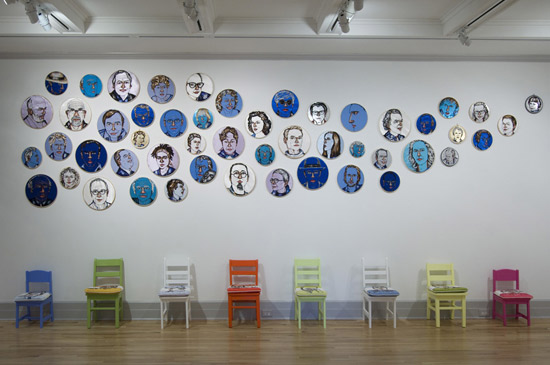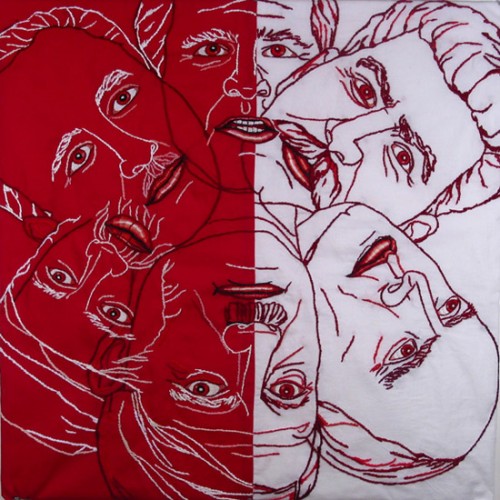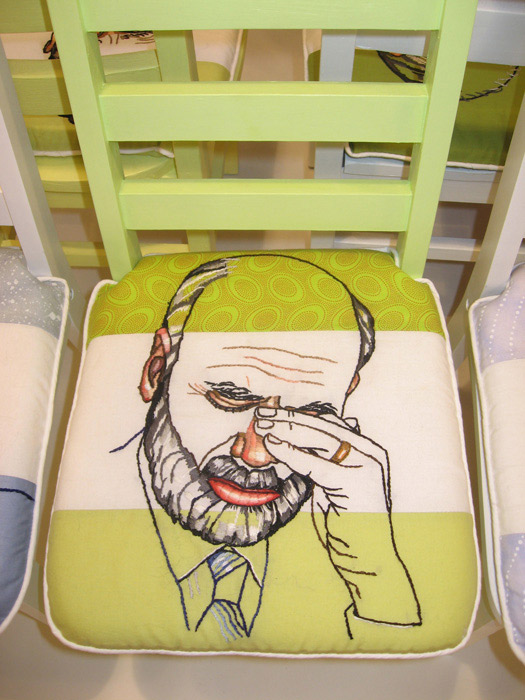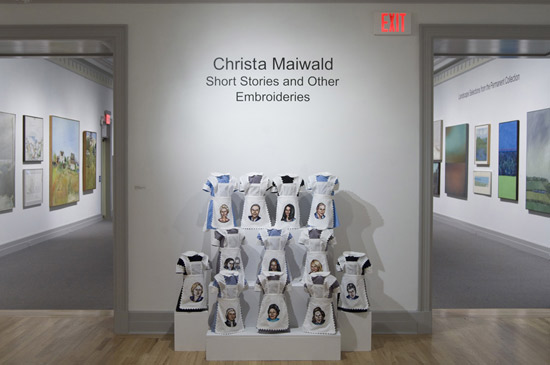Thirteen years ago, Christa Maiwald was offered a show in Italy. At that time, she was painting and the cost of shipping all the works for an exhibition of any significance seemed prohibitive. So the artist started pondering alternatives.
Maiwald came up with a solution after realizing that if she were to stitch a body of work, it would be as easily transportable as personal luggage. In that realization, she stumbled upon what would become her preferred medium through to the present day: hand embroidery.
“Short Stories and Other Embroideries,” on view at Guild Hall Museum through Jan. 5, 2014, displays works from five series developed over five years. The one-woman exhibition, which shows off Maiwald’s skill with conceptual statements and handiwork, was awarded to the artist as the winner of Best in Show in Guild Hall’s 73rd Annual Members Exhibition in 2011. Maiwald’s work was selected for the prize by guest juror Deborah Cullen, Ph.D., Director of Curatorial Programs at El Museo del Barrio, New York.
.

Installation of "Blue Chip" and "Musical Chairs: Economic Crisis in G minor" by Christa Maiwald at Guild Hall Museum. Photo by Gary Mamay.
.
Embroidery is one kind of needlework art—considered a craft by some—that was branded as “women’s work” in the 19th century. (Because of this, in the 1970s, such handicraft became a feminist statement.) Historically, sewing for practical reasons (tailoring, patching, mending, and reinforcing cloth) has frequently led to exploring its decorative possibilities, and the fundamental techniques of embroidering by hand have remained fairly constant through hundreds of years.
For Maiwald, embroidery was not an immense leap, since she had always sewn, and the medium didn’t require intense research or study. Employing three basic stitches—the blanket stitch, running stitch, and French knot—the artist primarily portrays iconic figures and moments in history, politics, entertainment, and art history in a frequently humorous, whimsical manner that does not, however, deflect the subjects’ gravity. (An earlier and fascinating body of work portraying childhood and adolescence is not included in this show.)
Somewhat surprisingly, Maiwald chose to represent the figure in her needlework, even though she maintains that she has little talent for drawing (a reason for devoting the early part of her career to working in film and video).
Using an image culled from a newspaper, magazine, the Internet, or a photo taken by her or husband Mark Segal, Maiwald first draws her subject, transferring the image onto a fabric that is preferably lighter in strength and color so that the drawing is clear and the subsequent image most effective and compelling. As she describes it, “the final drawing is a faint outline on the chosen fabric. Then I start with the eyes, and just keep going. I love doing eyes.”
.

"Blue Chip (Laurie Anderson, Andy Warhol, Laurie Simmons, Dennis Oppenheim)" by Christa Maiwald, 2009-11. 50 hand-embroidered portraits on cotton, individual portraits from 7 to 14 inches in diameter. Photo by Gary Mamay.
.
Indeed, the eyes are the strength of any portrait, as they are for Laurie Anderson or Dennis Oppenheim (or even the enigmatic Andy Warhol, shuttered by shades) from the Blue Chip series (2013); or the coiffed semblances of Courtney Ross and Naomi Campbell in Servitude (2008), an installation of several small maid uniforms with embroidered pinafores; or the impassive (threatening?) gazes in White Guys, a piece from Dictators (2008) portraying Stalin, Franco, Hitler, Bin Laden, Mussolini, and Bush—the last perhaps being the poorest example of stolidity as captured by Maiwald.
.

"White Guys" by Christa Maiwald, 2008. Cotton, thread, hand embroidery, 25 x 25 inches. Photo by Gary Mamay.
.
Expression, gesture, and stance are ultimately what pack the punch in most of the work. The likenesses of Ben Bernanke or Bernie Madoff on the seat cushions of small, brightly colored chairs, part of a suite entitled Musical Chairs: Economic Crisis in G Minor (2009), are frozen moments that remain in memory throughout time.
.

"Ben Bernanke, Musical Chairs - Economic Crisis in G Minor" by Christa Maiwald, 2009. Six children's chairs, hand-embroidered cushions, installation dimensions vary, photo by Gary Mamay.
.

"Bernie Madoff, Musical Chairs - Economic Crisis in G Minor" by Christa Maiwald, 2009. Six children's chairs, hand-embroidered cushions, installation dimensions vary. Photo by Gary Mamay.
.
Time is a constant. There is the time devoted by the artist to plan, draw, trace, and finally stitch each piece, with the thread colors notably going unplanned, being selected as the stitching progresses. There is the time that is captured in each embroidered image, whether a compression of a moment or event, or synthesis of multiple events, real and imagined. There is the time the viewer allows the eyes to follow each stitch, often with jaw agape in awe of the artist’s process.
In the 1951 short story by Ray Bradbury titled Embroidery, three women facing a possibly apocalyptic end sit in their rockers trying to stitch the world around them into embroidered patterns, attempting to stop time as they count down to the 5 o’clock hour when something will happen, an unknown experiment that may change their surroundings, their lives as they know them. Time here is the constant reference, building rapidly toward the denouement, these women’s fate in its hands.
Maiwald’s embroidered patterns are also stitched representations of what surrounds her, though in her case this consists of situations and individuals she feels compelled to comment on or decry. Celebrity and renown especially–for good and bad behavior—figure widely in her portraits. However, the artist is not overtly judgmental or preachy. Through a juxtaposition of subjects and a playfulness of representation and composition she achieves open-ended commentaries that resonate rather than dictate.
.

"Courtney Ross and Naomi Campbell, Servitude" by Christa Maiwald, 2008. Hand-embroidered cotton thread on handmade miniature maid's uniforms, installation dimensions vary. Photo by Gary Mamay.
.
Are Maiwald’s Short Stories also a countdown to an end? Of innocence and virtue? The authentic artist? Selfless leadership, true patronage, faithful service?
The women in the Bradbury story comment on their activity:
“‘It seems at times like this that it’s always your hands you turn to,’ she said, and the others nodded enough to make the rockers rock again.”
“‘I believe,’ said the first lady, ‘that our souls are in our hands. For we do everything to the world with our hands. Sometimes I think we don’t use our hands half enough; it’s certain we don’t use our heads.’”
Christa Maiwald has found a most compelling way to put her hands—and our heads—to the test.
.

"Servitude" by Christa Maiwald. Hand-embroidered cotton thread on hand-made miniature maid's uniforms. Photo by Gary Mamay.
BASIC FACTS: “Short Stories and Other Embroideries” remains on view through Jan. 5, 2014 at Guild Hall Museum. An Artist Talk will be held on Sunday, Nov. 17, from 2 to 3 p.m.
Guild hall is located at 158 Main Street, East Hampton, NY 11937. www.guildhall.org.
Christa Maiwald is based in East Hampton, NY. www.christamaiwald.com.
RELATED: "Sneak Peek - "Short Stories and Other Embroideries" by Christa Maiwald" by Pat Rogers. Published Oct. 25, 2013.
________________________________________
Copyright 2013 Hamptons Art Hub LLC. All rights reserved.
